Caseless ammunition has always been an interesting topic on the fringes of arms design – people keep trying it out, but none of the systems seems to really get a solid foothold in a civilian or military market. Ever wonder why? Well, a fellow named Jim Schatz gave a presentation at the 2012 NDIA Joint Armaments Conference in Seattle discussing the history of caseless ammunition and the characteristics of caseless rifle systems. We don’t know the man personally, but apparently he spent several years in the US ACR trials, and has as much hands-on experience with the H&K G11 as anyone. I wish I’d been able to see the presentation in person, because the PowerPoint slides that he used are both informative and humorous.
In fact, thanks to reader Juul, we have a copy of those slides for you, in PDF format. I would encourage you to take a few minutes to read through them – even as just slides, the pros and cons of caseless systems are made pretty clear. Here are a couple examples:

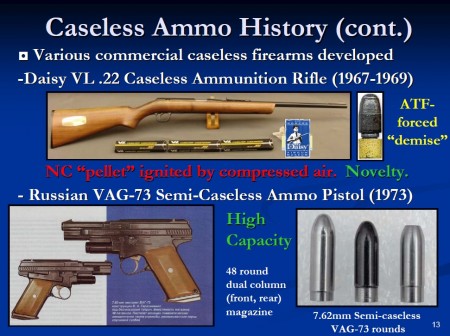
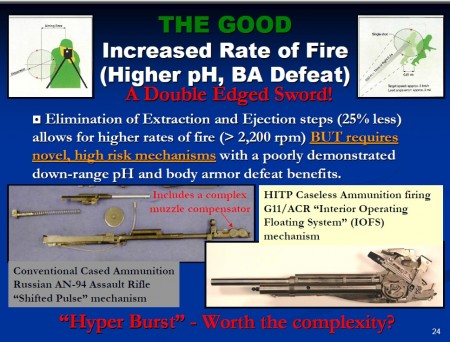
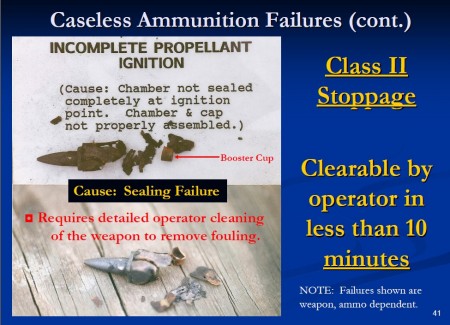
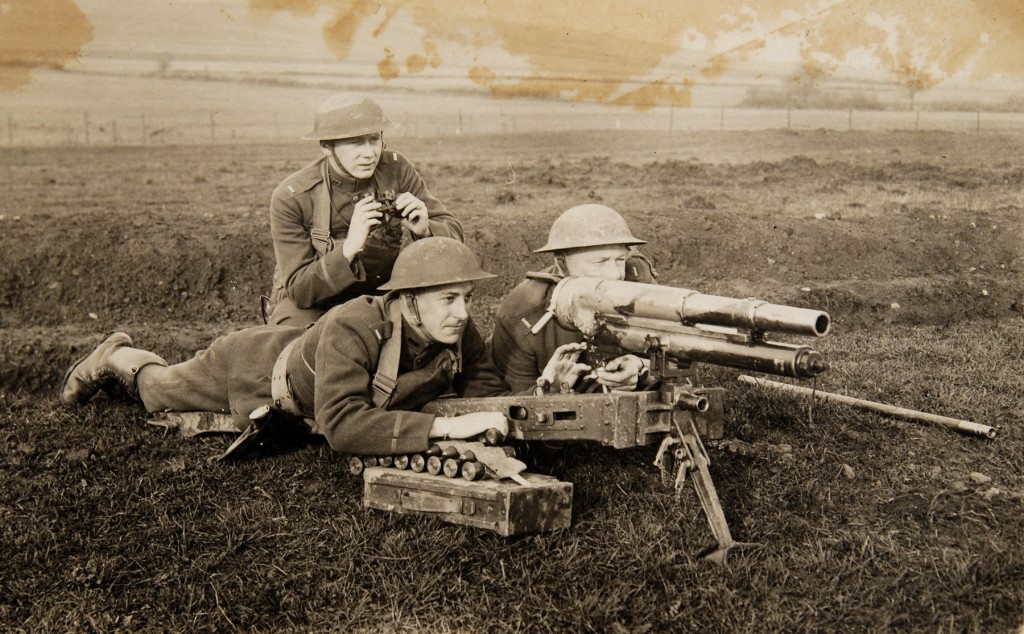
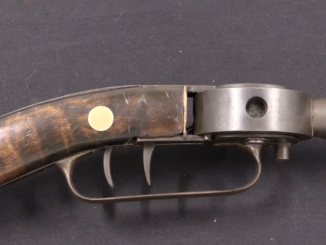

Sweet. Thanks.
Am I the only one to read that as “Careless Ammunition Overview”?
Gerald, I can’t find how to do a direct post. I have 7 rounds of what I believe is caseless ammo. It measures.24 lead bullet. How can I send pictures to Ian for his help in identifying them. Thanks, Rich Travalini
Interesting compilation of the pros and cons of caseless ammunition.
I do have to wonder at the prejudice of the author. He doesn’t show some of the stoppages possible with conventional ammo, or accidents. Conventional ammunition is hardly perfect. He doesn’t give mean time between failures (MTBF) nor the mean time between accidents (MTBA). Surely in such a discussion this is important. I find it interesting that he mentions the inability to re-load caseless ammo. Well, this is hardly a problem with military users, nor with most civilian ones. I understand the Voere rifle was superbly accurate, and changing the bullet was simple. Pull one out, insert another. Apparently it was as straightforward as that.
I do agree that an excellent case is made against caseless ammunition, but perhaps a more balanced study would be more interesting. I, personally, would like to see the statistics regarding MTBF, MTBA, and a breakdown of the reasons.
This was not an analytical in-depth work, apparently. It was a sum-up of one individual’s recollections who was involved in programme, supported with collective mental background of greater community. As a result, I would not expect anything more or less out of it. This kind of messages are repeating like some sort of echo lately. It just seems to underline that this approach (caseless) remains impractical in foreseeable future for military arm application. WAs it failure? Not necessarily so; it was attempt to be sure. That’s all folks.
Great questions to ask! I agree that his bias is showing. All weapons require cleaning and have malfunctions. Back in the fifties, the army tested half a dozen of all of the major competitors to the Garand/M-14/ T-44, including the AK-47, FN-FAL, H&K G-3 and one other I can not remember at this instant.
To the best of my memory, the simple results were;
1. AK-47 with 4 Non-Ammo related stoppages out of >100,000 rounds.
2. M-14 et-al 6 ” ” ” ” ” ” >126,000 ”
3. H&K G-3 12 ” ” ” ” ” ” <100,000 "
4. FN-FAL 26 " " " " " " <85,000 "
The number of rounds was determined by the team's ability to load and fire the guns in a timely manner.
What was not published because the Army wanted more money for R&D, was that the number of "Failures to fire" was affected by the ammo. The average number of rounds between stoppages resulting from bad ammo was more than one in 1,000 for the AK-47 and less than one in ten thousand for the western loaded 7.62X51 used in the tests. There was four types of 7.62X51 ammo used in the tests, from each National armory ammunition provider. This was because not all 7.62X51 ammo is the same. It is interchangeable, but will not shoot to the same point of aim, or have the same terminal effect. The American ammo was a 147 Grain Streamlined ( Boat tailed) bullet at 2,800 FPS, or 9.53 Grams @ 853 M/S. The British ammo was loaded to 2,750 FPS and the German ammo to 2,700 FPS. Both the Brits and Germans used flat base bullets which did not carry as far, but did not wear on the barrel as much. ( I think the flat base seals the bore better?)
The main causes of failures were the adjustment of the gas regulator in the FN-FAL causing failure to extract, or eject. The G-3 failed when the piston got gummed up, because it's two position regulator was either two much or to little or the carbon built up in the rollers which could take over an hour to clean by the shooter. The M-14 was self regulating and did not suffer these types of failure nearly as much. A small number of failures resulted from broken parts with the M-14 having the fewest(1) of this type of failure by a wide margin. Three to many in each of the other guns. The basic Garand mechanism was well sorted by this time. The guns were tested for accuracy, both before and after the test. Only the AK-47 showed any great loss of accuracy, but was so poor at the start, they figured it did not matter. ( 8-14 MOA when new!) There were typical differences in the required accuracy between the types. The M-14 was required to shoot into 2.5 MOA when accepted by the Army, those that did not were returned for remedial service. The FN-FAL was next most accurate at between 3-4 MOA and the G-3 next at 4-5 MOA. All with the ammo supplied by the Service National factories.
Now on to the best part!
The H&K G-11 was in the early stages of service production after having been accepted by the German Army. It had passed all test and service requirements and was considered the finest rifle in the world at the time. It was almost as accurate as the American guns and more accurate than all the rest. It jammed less and was much more reliable than any other weapon they had tested.
It's only defect was the very hard recoil when shooting three shot bursts. The action floated in the stock and the recoil of all three shots hit you all at once after building up speed. It recoiled more than the G-3 which is easily the hardest shooting of the common 7.62X51 rifles. (By the way when the gas regulator of the FN-FAL is adjusted just right, it is the softest shooting of the bunch! The bolt never hits the buffer! But will fail to eject, or extract at least once in every other magazine)
The G-11 was also very controllable in normal full auto fire, more so than the M-16 and any of it's clones. Something about the floating action, I think? No other service rifle is as controllable in full auto as the M-16 and it's clones! Any direct impingement SCHV weapons including the AK-74 with its 5.45X40 ammo. The British SA-80 is the only one that is close among the piston guns.
So to sum it up, the G-11 and it's caseless ammo was the best infantry weapon to ever reach service, but was overtaken buy politics and money troubles of the West Germans after the fall of the Soviet union.
The author is Jim Schatz.You’ll find him hkpro.com as G3kurz from time to time.
I don’t think there has been much success in caseless ammo and weapons systems since the demise of cap&ball revolvers. ( Sorry, my excuse for humor.)
The Daisy VL really seemed to work well. But back then, there wasn’t the consumer demand that a gun had to hold multiple rounds of ammo. Where I grew up everyone hunted, with pheasant hunting being the most popular. It was considered a luxury to have a shotgun that wasn’t a single shot. ‘Deer rifles’ tended to hold multi rounds.
The VL I shoot as a kid was owned by my uncle who had bought. My use would have been 20-25 rounds total.
That the Heckler & Koch G11 nearly made it to general issue surely argues that caseless ammunition can be made to work. Let’s face it, H&K make some of the best firearms in the world. It beggers belief that they would get a firearm to the point of general issue with the Bundeswehr, which didn’t happen due to minor political issues such as reunification, and yet have developed something as non-functional as this author thinks. I think he overstates his case, and in reality, hasn’t come up with anything new, because some of his examples are ammunition for the H&K G11, which must be over 30 years old, and these must have been at least acknowledged back in the 1980’s when the G11 was under development. I still want to see the statistics behind his claims, because then he will have presented all the information rather than his interpretation.
G11 was under development since around 1970; the amount of effort in intellectual and monetary sense was enormous, yet result is – nothing. The story of Bundeswehr being on verge of adopting it while Fall of Berlin Wall somehow stuck in between is an urban legend. In my understanding of world developments, everything was well planned decades ahead. No member of NATO has gone yet, or will go with their own unique and non-interchangeable ammunition. Mother Goose tried once; what was the result?
I belive the Dasy”diesel” airgun, was made in the 50ties. in mid 30ties walther, had a well working, but unsusselful desin as a submashingun.
I believe there was also a German ether powered offshoot of an air rifle in the ’60s or ’70s. I think it was called the “Barakuda”.
Until the persistent issues of caseless ammunition ( adequate protection against rough battlefield handling and storage for the otherwise exposed propellant, heat dissipation problems, etc. ) are properly resolved, Cased Telescopic Ammunition ( CTA ) appears to hold much more promise for the near future.
It appears that a number of U.S. military contractors are moving forward with telescoped, polymer cased ammunition in the LSAT program, rather than caseless ammunition. Here is a link to the two page brochure from AAI Corporation on their LSAT LMG and its associated ammunition:
http://www.aaicorp.com/pdfs/LSAT.pdf
There is also a caseless version of this telescoped ammunition, but AAI describes the polymer cased version as a ‘lower risk’ technology. The polymer cased ammunition LMG uses a rotating chamber, which may be intended to reduce extraction problems.
why did they call the crap that got blasted out of the gun “battle spores” was it just to sound cool?
Are you the owner of http://ianmccollum.net/ the page that says “we’ll isn’t this nice…… My own web page
Nope, not me.
Cased Telescopic Ammunition ( CTA ) definitely has greater potential, at least in the foreseeable future, than caseless ammunition. Until the main problems ( adequate protective coatings for the formed propellant that won’t break down due to rough handling and other battlefield exigencies, heat dissipation issues, etc. ) associated with the latter are thoroughly resolved, caseless rounds will remain a good idea and not much more.
Interesting as always.
I wouldn’t mind seeing something on that VAG-73 automatic pistol.
Here is a link to the pretty detailed description (in Russian) of the VAG-73. Aside from the unique ammunition it uses, most interesting feature about this pistol is the magazine which allows it to hold 48 rounds.
http://www.mycity-military.com/slika.php?slika=59102_314044856_VAG-73%2001.jpg
http://www.mycity-military.com/slika.php?slika=59102_314044856_VAG-73%2002.jpg
http://www.mycity-military.com/slika.php?slika=59102_314044856_VAG-73%2003.jpg
http://www.mycity-military.com/slika.php?slika=59102_314044856_VAG-73%2004.jpg
http://www.mycity-military.com/slika.php?slika=59102_314044856_VAG-73%2005.jpg
Thank you very much for posting this article. Very interesting and – as you said – pretty detailed. I didn’t knew the designer of the VAG-73 was an engineer working in the aeronautics field. It might explain some things though…
the Austrian Voere VEC91 hunting rifle was designed for hunting fast moving game like running german boars as in this video showing the use of a conventional bolt action rifle in this way (http://www.youtube.com/watch?v=bKh_13zOGFc)the argument for this rifle in favor of convetional rifles was of course its virtually non-existent lock time and high velocity projectile.
Oh geez… Powerpoint presentation designed for military persuasion? Well, I’ll slog through it and try to ignore how awful it is. There’s a lot of good information in there that’s difficult to find elsewhere, it seems.
you didnt exsplian why you thought it was awful
My bad.
It’s kind of more a thing if you’re familiar with military presentations involving powerpoint. It’s not the content, it’s the delivery. Low-res graphics, kinda crappy colors… I mean yeah, we’re not expecting photoshop here but the whole affair makes it difficult to take seriously. Like, it’s not super clean, you know?
In Phillip Sharpe’s book “Handloading” he (as an officer who reviewed German small arms ammunition at war’s end) did mention the German attempts at caseless ammo, as mentioned in the Power Point slides. But in regards to steel cased ammo, he indicated that the Germans were using it across the board with the exception of the German air force (what with failures to extract and such being a bigger problem in the air fired with guns fired by remote control, Goering ordered brass ammo only for the air force). The point being that the slide deck sort of implied that the Germans could not get casesless ammo to work so they went with steel, when it seems like they really went to steel before much was done with caseslss ammo. Not a big issue, just a clarification. His (Sharpe’s) work did give some interesting history on the development of the coatings that went onto steel cases, the coatings being the key part of steel cases. It is a great book even if one does not handload, it is just as much a history book on ammunition making.
What was F troop’s problem with the Daisy rifle?
From back before the time of the wars of German unification (under Prussia), the Prussians had a system of economic protectionism which makes Hamilton’s tarriffs in the US appear tame by comparison.
A tradition became established, where if something couldn’t be made in Germany, a substitute – even if drastically inferior in service or more costly, was to be used.
I suspect that the development of steel cases was another example of “ersatz”
one which seems to have eventually worked out pretty well
Thanks for posting. It’s always nice to come across information on this rarely used technology.
The obturation problem for caseless firearms has always bugged the heck out of me. The presence of weapons such as the VEC 91 however, would seem to imply that the issue isn’t as ‘insurmountable’ as the author suggests. The Austrian rifle is said to have a muzzle velocity of 930 m/s, which is something that you would hardly expect from a ‘leaky’ weapon. In addition, heavy artillery, with bagged propellant or combustible cases seems to have dealt with this successfully for over a century.
Artillery guns using bagged charges or combustible cases are generally designed such that the projectile is seated very close to the rearmost rifling of the barrel. By the time the propellant charge behind it has fully fired, the projectile has already started its initial travel into the rifling, thus forming a gas-tight seal. The same basic principle applies to smooth-bore guns, except that no rifling is present and a sleeve or sabot around the projectile provides the gas seal.
The problem with telescoped ammunition of any kind, cased and caseless alike, is that there is propellant in front of and around the projectile, implying that much gas would potentially be wasted traveling ahead of said projectile. Interestingly enough, the solution to this originated with the famous German 88mm Flak 36 and 37 AA guns of World War Two. The high chamber pressures and temperatures were causing premature wear of the first few inches of the rifling, resulting in what was effectively an oversized chamber that allowed blow-by before the shell could engage the intact rifling further down the barrel. The problem was resolved by placing a small starter charge directly behind the shell and ahead of the main propellant charge. A flash tube connected the starter charge to the primer in the base of the cartridge. When the primer was ignited, it triggered the starter charge first, which pushed the shell out of the cartridge case and into the rifling before the main charge exploded. A similar approach has been adopted for CTA ammunition with much success.
With telescopic caseless ammunition, it is much harder to reliably incorporate a starter charge and flash tube into the exposed propellant during the manufacturing process, so mechanical sealing rings are made as part of the gun to provide the required gas-tight seal. The ammunition itself can then stay simple, basically a chunk of formed propellant with the projectile recessed within and with a combustible firing cap at the rear.
There is a published patent for this type of ring seal device at http://www.google.com/patents/US5777256. It was filed in the United States on May 1st, 1997 by Franck Bouvard and Fran Simon of France’s GIAT Industries, although indications are that the design itself preceded this filing by some years. It was published on July 7th, 1998 as Publication Number US5777256 A ; other publications include DE69511667D1, DE69511667T2, EP0717253A1 and EP0717253B1.
So?
The VEC91 does not use telescoped ammunition…
I wasn’t referring specifically to the VEC91 system, which I am quite aware uses a round where the projectile protrudes beyond the formed propellant ; I was discussing the general precepts and relative design issues of caseless ( a lot of which is telescoped to further reduce the length of the rounds and enable a gun with a more compact receiver to be used ) and CTA ammunition.
Sorry, I should have added a paragraph explaining this to my previous post.
While I think that CTA is probably the way to go, I think the author tends to focus more on issues with the G11 than caseless ammunition in general when he gets to “The Ugly” section of his presentation. Even his the issue he mentions with regards to the sealing of a chamber is perhaps a little bit exaggerated, as everything I’ve read on the GAU-7 suggests that the failure of the program was the issues they had with the ammunition being difficult to mass produce and not performing well when exposed to humidity, not any issues with sealing the chamber.
Personally, I think that anyone wanting to do caseless ammunition today should probably take a look at the GAU-7’s ammunition and introduce improvements developed in the last 40 years in terms of combustible cased ammunition and thermal coatings. I think things have advanced sufficiently for CC ammunition that isn’t affected by humidity to be produced. Combine that with the LSAT or maybe a modified version of the Steyr ACr, and I think you’d have a viable caseless weapon.
The French Chassepot and Dryse needle guns used caseless ammunition. It required the use of a ramrod to unload. They were dirty and dangerous. The Daisy I remember as a kid. It shot really well and was fun to shoot. My dad thought it was dangerous and sold it and the ammo off for a considerable profit. I still have a few rounds. It may have been a good idea if it was allowed to evolve. This caseless idea comes back every generation. From the Volcanic rocket ball of the 1850s to the Gyrojet of the 1960 it never seemed to work. I understand H&K developed a caseless round for an assault weapon system. I think unloading and cartridge fragility were problems that could not be overcome. This was a very interesting post and overview. Food for thought.
I own and shoot a Chassepot. While it is a dirty gun to shoot I wouldn’t say it’s dangerous. It has a very rugged and almost fail proof safety. It is also light years ahead of the muzzleloaders that it replaced in speed of loading and firing, accuracy and power. Sure unloading the Chassepot required the use of the ramrod but it only takes a few seconds if it needs to be done and is far easier to unload than any muzzleloader. The ammunition is somewhat delicate but is still rugged enough to be rammed into the chamber by the closing bolt. And like any caseless ammo gun it’s kind of cool not to have a case to eject (nor to clean).
I too shoot a Chassepot and agree the safety is foolproof. I have seen chamber have embers from the last shot fired. The gas seal washer also can melt but I have never fired it fast enough to know.The are depictions of French soldiers having to urinate on the breech to clean the fouling of the action. Again outside of my experience thankfully. The unloading is indeed faster than a muzzleloader.I feel the conversion of the Chassepot to metalic cartridges was both much safer and faster still; without the fragility of the Chassepot cartridge. Thank you for your reply. Question does your Chassepot shoot high at 100 yards/meters. Mine ishas a tendencey to shoot a foot or so above the point of aim…all the best
My Chassepot does indeed shoot high and a little bit to the left. This rifle does have one interesting feature that I learned about from a French website, that it has a reduced range rear sight that becomes evident when you flip the sight ladder forward. I believe it is set for 100 meters.
That feature of the rear sight was on all French rifles until the new Rifle of 1936. Sometimes the rear sight notch is off center but it is intended to be that way for zero.
I believe on Lebels and Berthiers the fold down notch are set for 150 meters.
This is probably the only place on the planet where we can hear from not one, but two active Chassepot shooters.
Now all I need is someone who’s shooting a Dreyse Needle Gun and my day is complete.
What was the connection with the ATF and the end of the Daisy VL rifle ? I never heard or read anything about it. I bought a bunch (15,000) of the VL ammo later for about 8 rounds for a penny from I think Numerich? I thought I have 3 boys and they will shoot it up saving me a lot of money But the pull the lever load a round close the lever take the safty off pop and repeat didn’t thrill them so they went back to loading mag after mag for the 2 Ruger 10-22s I had and went pop pop pop ect. No savings there.
I think it had something to do with the wording of the law defining a firearm as firing “fixed ammunition” .
The article on the russian pistol was interesting,but, my russian is non-existant. Can anyone out there translate the article?
Thank you, Jim Schatz and all this intresting people.
I own a Chassepot to. This is the real caseles beast.
Freaky and unsafe to shot but makes the diference.LOL.
There seem to be a surprising number of Chassepot owners on the FW site — how about a follow-up article on the Chassepot? It would be great food for thought and discussion.
After I got my Chassepot I did a fairly extensive write up about my experience on the Cast Bullet Association’s forum. You can find it here
http://www.castbulletassoc.org/forum/view_topic.php?id=6657&forum_id=6&highlight=chassepot
I don’t believe you need to register to read the forum.
Thanks for the reply and the link, Mike — your help is much appreciated!
I have to say I have long agreed with Schatz. (This presentation, and the others from NDIA, are available to the public on DTIC, via their website. Look for Infantry and Small Arms symposia, primarily.
http://www.ndia.org/resources/onlineproceedings/pages/default.aspx
Former member here (when it was the ADPA actually).
I’m guessing if this kind of analysis was done for the M-16 when it was first issued to troops in Vietnam, there would no longer be an M-16.
need information on PELE ammunition technology ALP technology,AHEAD ammunition Technology